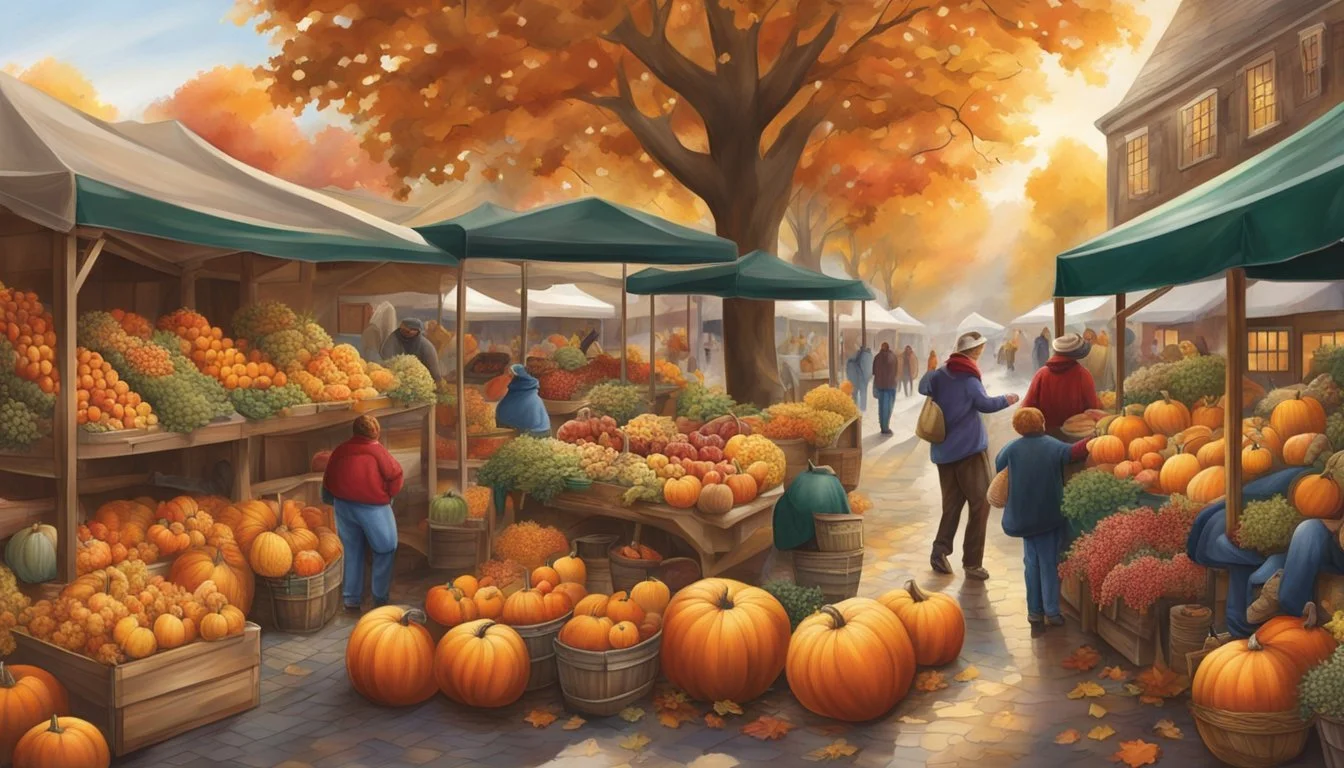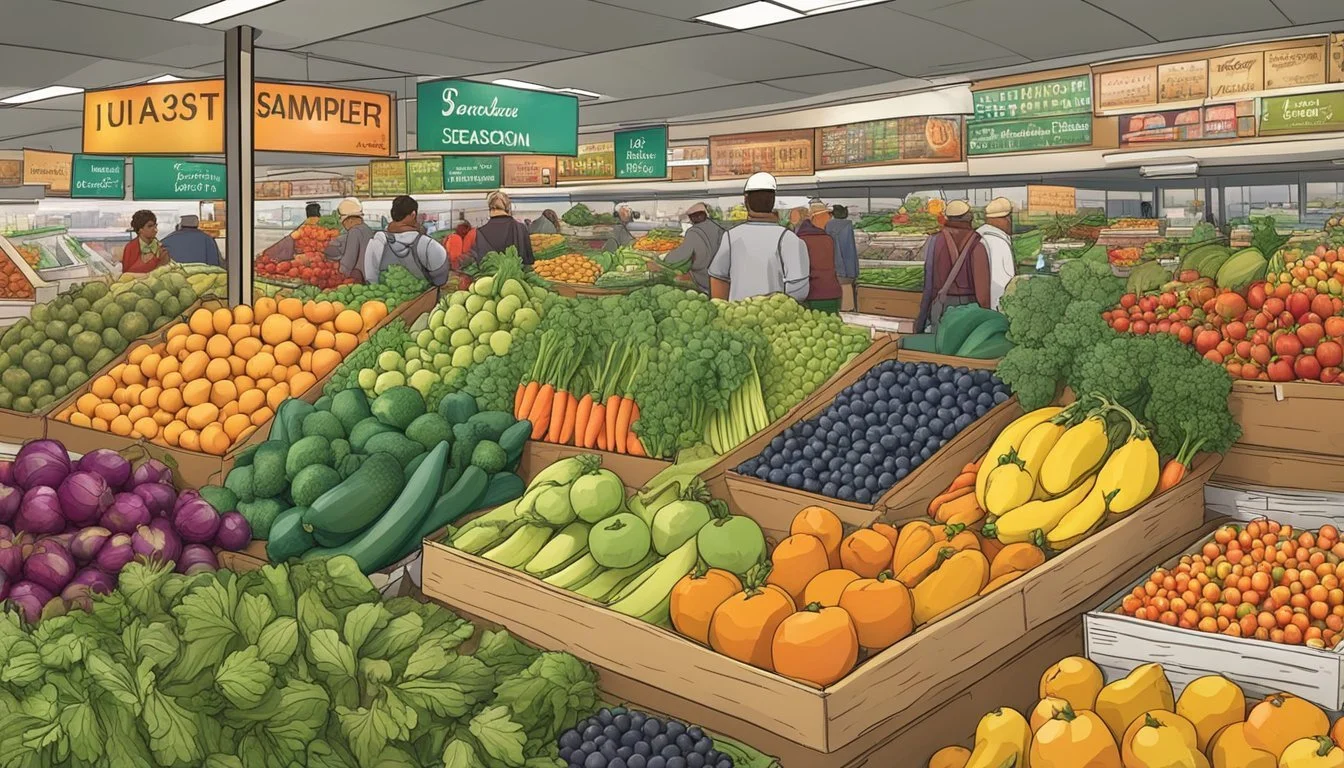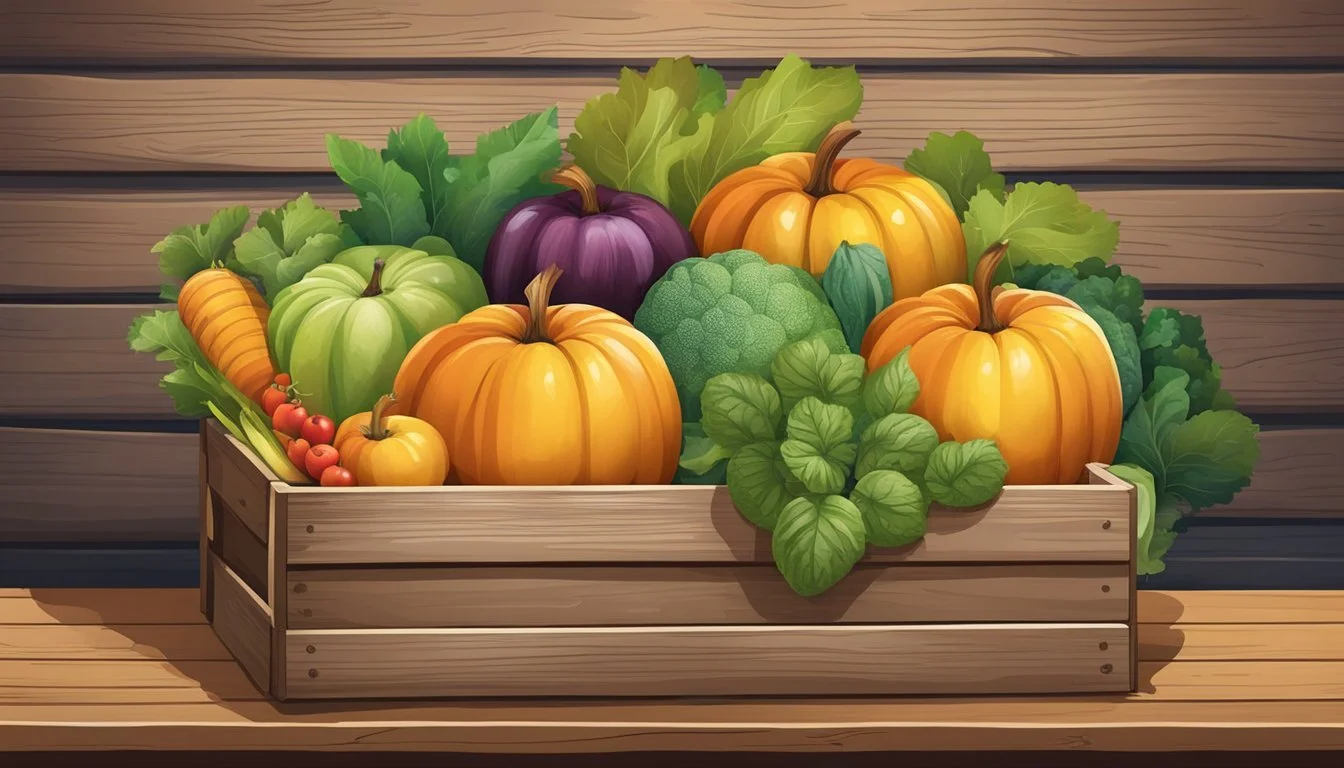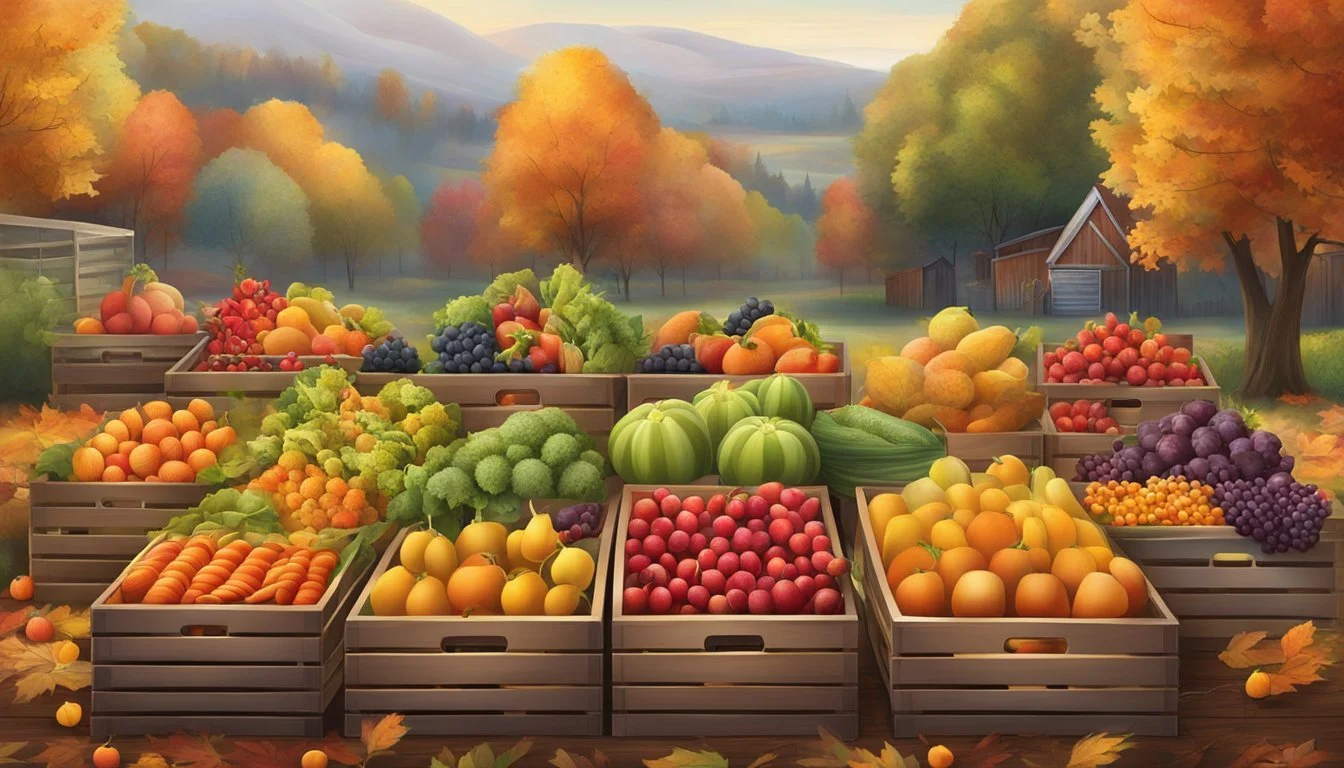Indiana Seasonal Fruit & Vegetables in November
Your Guide to Local Produce
This Article is Part of our Indiana Seasonal Fruit & Veg Calendar
As the vibrant leaves of fall make way for the brisk chill of approaching winter, November in Indiana marks a transitional period for local agriculture. This is a time when the harvest season is reaching its culmination, and the bounty of the state's farms is particularly varied. Residents and chefs alike turn towards the season's offerings for not only their holiday tables but also for daily nutrition. Seasonal produce in November is a testament to Indiana's rich agricultural tapestry; root vegetables and hardy greens typically withstand the cooler temperatures, while some fruits make their final appearance.
The cooler climate allows for the extended availability of some of Indiana's robust fall harvests. Root vegetables like sweet potatoes, turnips, and radishes remain in prime condition, along with various types of winter squash, which have become synonymous with autumnal fare. Greens such as kale (What wine goes well with kale?) and collards can still be found fresh in the fields, their flavors often enhanced by the frosty nights. Moreover, late apples and pears are among the last fruits to be plucked from the orchards, offering a sweet balance to the earthy flavors (What wine goes well with earthy flavors?) of the vegetables.
Understanding the seasonal produce of Indiana not only assures one of enjoying the freshest ingredients but also supports the local farming community as it prepares for the dormant winter months. Consumers who choose seasonal items are likely to experience both the peak flavors and nutrient content offered by these foods. For November, this includes embracing the last of the fall harvest and those hearty crops that are harvested in this bridge month before the full onset of winter.
Importance of Eating Seasonally
Eating seasonally revolves around selecting and consuming produce that is naturally harvested at the time of year they are ripe and ready. Doing so can provide a multitude of benefits, spanning from nutrition to environmental sustainability.
Nutritional Value: Seasonal fruits and vegetables are typically harvested at their optimal ripeness, meaning they have had enough time to develop a full spectrum of vitamins, minerals, and antioxidants. These nutrients are at their peak in season, making the produce not only taste better but also be better for one’s health.
Flavor Enhancement: There is a distinct difference in taste when it comes to seasonal produce. Fruits and vegetables consumed during their appropriate seasons are often fresher and, consequently, have a more vibrant and robust flavor profile compared to out-of-season counterparts that may have traveled long distances and are often picked before they are ripe.
Sustainability: Seasonal eating supports sustainable practices in farming. It tends to reduce the demand for out-of-season produce that requires more transportation and storage, leading to a decrease in energy consumption and greenhouse gas emissions. This practice can also play a role in supporting local farmers and markets.
Availability and Variety: Eating seasonally encourages a diverse diet because it introduces consumers to a wide range of produce throughout the year. Seasonal availability often results in a plentiful supply of certain crops that can lead to more affordable prices for consumers.
In summary, incorporating seasonal produce into one's diet is a powerful way to enhance nutrition, savor more flavorful food, foster sustainability, and benefit from the abundant variety each season has to offer.
November in Indiana
November in Indiana marks the transition from fall to winter, affecting both the weather and the harvest times of local produce.
Weather and Climate Impact on Produce
The climate of Indiana in November typically features cool to cold temperatures with the approach of winter. These conditions can present a challenging environment for growth, with early frosts often arriving. However, certain hardy vegetables can endure and are even enhanced by the cooler temperatures.
Typical Harvest Times
In November, the harvest times in Indiana reflect the season's hardier selections. The following list outlines some of the typical produce one can expect to find:
Root Vegetables:
Beets
Turnips
Radishes
Cruciferous Vegetables:
Cabbage
Cauliflower (how long does cauliflower last?)
Kale
Collard greens (how long do collard greens last?)
Other Vegetables:
Sweet potatoes
Mushrooms
Lettuce
Celery root (celeriac)
These vegetables tend to be available due to their ability to withstand cooler climates and, in some cases, improve in flavor after a frost. Farmers plan for these conditions, sowing crops at times that will ensure readiness for November harvests.
Seasonal Fruits Overview
November in Indiana brings a selection of seasonal fruits that provide both quality and flavor. Consumers can expect to enjoy fresh, locally grown produce during this time.
Apples
Indiana's November climate is conducive to the production of late-season apples, which are known for their firmness and depth of flavor. Varieties like the crisp Honeycrisp and the tart Granny Smith are typically harvested at their peak during this period.
Pears
Pears are another November favorite in Indiana, offering a buttery and slightly sweet taste. Varieties like Bartlett and Bosc are in season, ideal for both eating fresh and culinary uses due to their texture and aroma.
Persimmons
Persimmons are a unique fruit that Indiana is well-known for, especially the native American persimmon, which becomes ripe in late fall. This fruit, with its rich and honey-like flavor, is a seasonal delicacy used in puddings, breads, and jams.
Cranberries
Although not widely cultivated in Indiana, cranberries reach their peak in the fall. They are available fresh in November and are favored for their tartness and vibrant color, commonly used in holiday dishes, sauces, and as a dried fruit snack.
Seasonal Vegetables Overview
In November, Indiana's cool temperatures bring out the best in a variety of vegetables that thrive in the chill of late autumn. This is the time for hearty, nutrient-rich selections ideal for warming dishes.
Kale and Leafy Greens
Kale and other leafy greens such as collards exhibit a deeper flavor after the first frost, making them ideal for November harvests. These greens are typically:
Kale: Known for its resilience to cold weather.
Collards: A southern green that's hearty and grows well in Indiana's climate.
Root Vegetables
Root vegetables reach peak season in November, offering a bounty of earthy flavors and essential nutrients. Prominent root vegetables in Indiana during this time include:
Potatoes: A versatile staple available in several varieties.
Beets: Their sweet, earthy taste intensifies with the cold.
Carrots: They are sweeter when harvested after a frost.
Sweet Potatoes: A fall favorite, providing a rich source of vitamins.
Turnips: Often overlooked, turnips offer a peppery yet sweet flavor perfect for autumn meals.
Cabbage Family Varieties
The cabbage family, also known as brassicas, are well-suited for November's cooler temperatures in Indiana. They include:
Brussels Sprouts (how long do brussels sprouts last?): They become sweeter with the cold, harvested August through November.
Cauliflower: Best in late fall, it has a sweet, nutty flavor after a frost.
Winter Squash Varieties
Winter squash including pumpkins are in abundance in Indiana during November. Squash varieties have a long storage life and are ideal for seasonal recipes:
Pumpkins: Not just for jack-o’-lanterns, but also for savory and sweet dishes.
Squash: Varieties like acorn, butternut, and spaghetti squash are plentiful and perfect for roasting or soups.
Where to Buy Seasonal Produce
Finding fresh, seasonal produce in Indiana during November is a satisfying endeavor for local food enthusiasts. The abundance of harvests can be found across various platforms, from bustling farmers markets to dedicated local farms, and from community-shared agriculture programs to well-stocked grocery stores and co-ops.
Farmers Markets Availability
Farmers markets are a hub for seasonal fruits and vegetables where one can find a variety of November produce. They often feature:
Brussels sprouts
Winter squashes
Root vegetables such as carrots and parsnips
Every farmers market also has its own set of schedules and locations. A visit to Indiana’s market directories will help shoppers find the closest markets operating in November.
Local Farms and CSAs
Local farms in Indiana may offer the chance to buy produce directly, ensuring peak freshness and support for the community's agriculture. November options often include:
Kale and collards
Turnips and rutabagas
Community-Supported Agriculture (CSA) programs, on the other hand, allow individuals to purchase a share from local farms and receive regular produce deliveries. This system supports farmers and provides consumers with the freshest seasonal produce.
Grocery Stores and Co-ops
While local and organic options may be more limited in grocery stores, they often stock a selection of Indiana's seasonal produce. Co-ops, specifically, focus on providing locally sourced items. Shoppers can expect to find:
Apples, stored from the fall harvest
A variety of winter greens
It's best to inquire at the store for details about the source of their produce to ensure it is locally grown. Co-ops in particular are known for their transparency regarding the origin of the goods they sell.
Benefits of Local and Organic Produce
Local and organic produce is celebrated for its sustainability and superior flavor profile. Organic fruits and vegetables are grown without synthetic pesticides or fertilizers, which can result in a purer taste. Additionally, these practices are gentler on the environment, leading to improved soil health and biodiversity.
Local produce often travels a shorter distance to reach consumers, meaning it can be sold fresher and typically retains more flavor and nutrients. Transporting produce over shorter distances also means reduced carbon emissions, contributing positively to the goal of sustainability.
Supporting local farmers markets and purchasing organic products aids in bolstering the local economy. Consumers’ spending directly benefits their community, fostering growth and financial stability for local farmers.
Flavor: Organic farming often produces fruits and vegetables with enhanced flavor due to the absence of artificial growth stimulants.
Sustainability: Organic and local agriculture reduces the carbon footprint and fosters eco-friendly farming practices.
Community Support: Buying local aids nearby farmers, which in turn strengthens the community's self-reliance.
Purchasing locally-sourced and organic goods is not only a healthy choice for individuals but also a responsible one for communities and the planet.
Preparing and Storing Seasonal Produce
Before storing any produce, it is crucial to understand the best practices for cleaning, preparation, and preservation to maintain freshness and flavor.
Cleaning and Preparation
Rinse Thoroughly: Vegetables like spinach and other leafy greens should be washed under cold water to remove dirt and potential pesticides.
Delay Washing: Fruits such as apples should not be washed until right before consumption to prevent premature spoilage.
Preservation Techniques
Freezing: Many fruits and vegetables can be frozen. For instance, blanched broccoli can be frozen to extend its shelf life for several months.
Canning and Pickling: Options like canning tomatoes or pickling cucumbers can preserve the harvest while adding a variety of flavors.
Storage Tips
Cool and Dry: Store onions and potatoes in a cool, dark place to prevent them from sprouting.
Refrigerate: Certain produce like apples and spinach should be kept in the refrigerator's crisper drawer to maintain quality.
Ethylene Producers: Be aware that some fruits, like apples, emit ethylene gas that can accelerate ripening and spoilage of other produce if stored together.
Seasonal Recipes and Cooking Tips
November in Indiana brings an abundance of seasonal produce that can transform any meal into a showcase of autumn’s bounty. From Thanksgiving feasts to cozy weeknight dinners, the emphasis is on incorporating fresh, local ingredients such as Brussels sprouts, cabbage, and butternut squash (how long does butternut squash last?).
Thanksgiving Dishes
Roasted Butternut Squash with Sage: Enhance the natural sweetness of butternut squash through roasting, then sprinkle with fresh sage for a Thanksgiving side dish that complements turkey and stuffing.
Ingredients:
1 butternut squash, peeled and diced
2 tbsp olive oil
Salt and pepper to taste
Fresh sage leaves
Instructions:
Preheat the oven to 425°F (220°C).
Toss the diced butternut squash with olive oil, salt, and pepper.
Spread on a baking sheet and roast until tender, about 25-30 minutes.
Garnish with fresh sage leaves before serving.
Healthy Snacks and Salads
Brussels Sprout Slaw: They may cook a slaw using thinly sliced Brussels sprouts as a base, adding a tangy vinaigrette and toasted nuts for crunch. It’s a refreshing snack or salad that brings a crisp texture and earthy flavor to the table.
Ingredients:
3 cups Brussels sprouts, trimmed and thinly sliced
3 tbsp olive oil
1 tbsp apple cider vinegar
1 tsp honey
1/4 cup chopped nuts (e.g., walnuts or almonds)
Instructions:
Whisk together olive oil, apple cider vinegar, and honey to create the vinaigrette.
Toss the sliced Brussels sprouts in the dressing.
Sprinkle with toasted nuts before serving.
Warm and Comforting Meals
Cabbage and Potato Stew: As the weather cools, a hearty stew with cabbage and potatoes makes for a satisfying meal. They may simmer the vegetables with broth and herbs until everything is tender and flavors are melded.
Ingredients:
1 head of cabbage, chopped
5 potatoes, diced
4 cups vegetable broth
2 tbsp tomato paste
Herbs (thyme, rosemary)
Instructions:
In a large pot, sauté the cabbage until it starts to soften.
Add potatoes, vegetable broth, tomato paste, and herbs.
Bring to a boil, then lower heat and simmer until vegetables are tender, about 45 minutes.
Conclusion
Eating seasonally in Indiana during November allows one to enjoy a variety of fresh, nutrient-dense produce while supporting local farmers and the community. Cauliflower and celeriac (celery root) stand out as nutritional powerhouses available until the end of November. These vegetables can be the centerpiece of many warm, autumnal dishes.
Here are some of Indiana’s November offerings:
Vegetables: Cauliflower, Celeriac
Herbs: Some hearty herbs may still be available
By incorporating these vegetables into meals, consumers directly contribute to a more sustainable future by reducing the carbon footprint associated with long-distance transportation of off-season produce. Local purchasing not only bolsters the state's economy but also encourages the consumption of produce at peak ripeness and nutritional value.
Moreover, the act of choosing seasonal produce helps in nurturing a sense of community. Farmers' markets become vibrant meeting places where knowledge and goods are exchanged. The commitment to seasonal eating helps maintain the viability of these local markets and ensures future generations have access to fresh, local food.
Embracing seasonal eating in Indiana nurtures the environment, the economy, and overall well-being. By doing so, individuals take an active role in fostering a resilient food system that thrives on local resources and sustainable practices.









